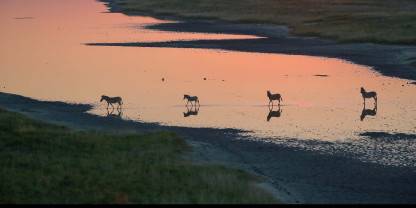Average Expert Rating
Rating Breakdown
Write a User ReviewThe Big Empty
The Makgadikgadi is an extraordinary place. Once, 20,000 years ago, there was a lake here, twice the size of Lake Victoria. Then it vanished, leaving the mosaic of soda pans you’ll see today. In the dry season you can drive by quad bike into their blinding emptiness, where the silence is absolute. But come back in the green season when the flamingos arrive by the thousand and you’ll find them transformed. This is the time to see herds of gemsbok and zebras munching their way across endless vistas of emerald grass. With luck you might see cheetah and Kalahari lion, too; but the true superstars of the Makgadikgadi are the rare brown hyena and the habituated meerkats you can meet at Jack’s Camp. This is the only place I know where you can get so close to them, and a stay here is an absolute must, not just for its stunning location in a palm grove on the edge of the Pans, but for its comfort, style and sheer romanticism. Ralph Bousfield, who owns Jack’s Camp, knows the Makgadikgadi like the back of his hand.
A Vast Nothingness
The Makgadikgadi Pans National Park offers a unique travel experience, with its vast open space, timelessness and complete nothingness. For much of the year, most of this desolate area remains waterless and large mammals are largely absent. But during and following the rainy season, the pans flood, attracting wildlife with large herds of zebra and wildebeest, followed by lion, cheetah and hyena. In very wet years, the pans fill with water, with thousands of flamingos and other waterbirds arriving.
The zebra migration heads for the Boteti River in the western Khumaga region of the national park. Around March onwards you can see hundreds of zebra flooding down to drink at the river. Wildebeest and bull elephants also gather here, although predators can still be tricky to find.
Lodges offer meerkat encounters, quad bike rides and, in the Dry season, the unique opportunity to sleep out on the pans, in the midst of the vast nothingness and ear-thrumming silence.
The World’s Largest Salt Pans
Within the park’s boundaries are a quite staggering juxtaposition of landscapes. In the west, relatively dense woodland occupies the high ground overlooking the often-dry Boteti River. Away to the east, islands of grassland (where you find brown hyena and I’ve even seen aardvark) fringe the white-as-white pans. Every year, one of Africa’s largest zebra migrations (with quite a few wildebeest as well) moves between the two, and it’s a wonderful sight at whatever stage of the migration you see them; they often stray beyond park
Read more
boundaries.Some of the best pans – such as Ntwetwe and Sowa Pans, with their isolated islands of baobabs, such as soulful Kubu Island – lie beyond the park’s boundaries. At the eastern end of the pan network (again, beyond the park boundaries) is Nata Bird Sanctuary with tens of thousands of flamingos and pelicans in the wet season (November to March). Also taking place outside the park are the visits (organized by local lodges and tented camps) to populations of habituated meerkats. I was lucky enough to do this at Jack’s Camp, and having a meerkat use my head as a lookout point remains one of my most unusual safari memories.
Dazzling Zebra and Shimmering Salt
Botswana’s great saltpans – Nxai, Ntwetwe and Sua – comprise an expansive region of northern Botswana known as Makgadikgadi: an ethereal and austere landscape like no other. Extending from the wildlife-rich Boteti River in the west to enormous Ntwetwe Pan – the largest of the saltpans – in the east, the 3,900 km2 Makgadikgadi Pans National Park protects large swathes of savannah grassland, iconic palm forest and Boteti River woodland, along with the western reaches of Ntwetwe Pan, within its confines. This lesser-known safari destination is home to a handful of luxury lodges and campsites.
While it might not claim the same predator-viewing potential as Botswana’s frontline reserves, it does boast extraordinary elephant viewing that rivals the world-renowned Chobe. Throw in an astounding diversity of habitats, picturesque wilderness campsites, and a dazzle of zebra second only to the Serengeti, and you have a year-round safari destination that’s difficult to omit from any itinerary exploring the best of northern Botswana.

